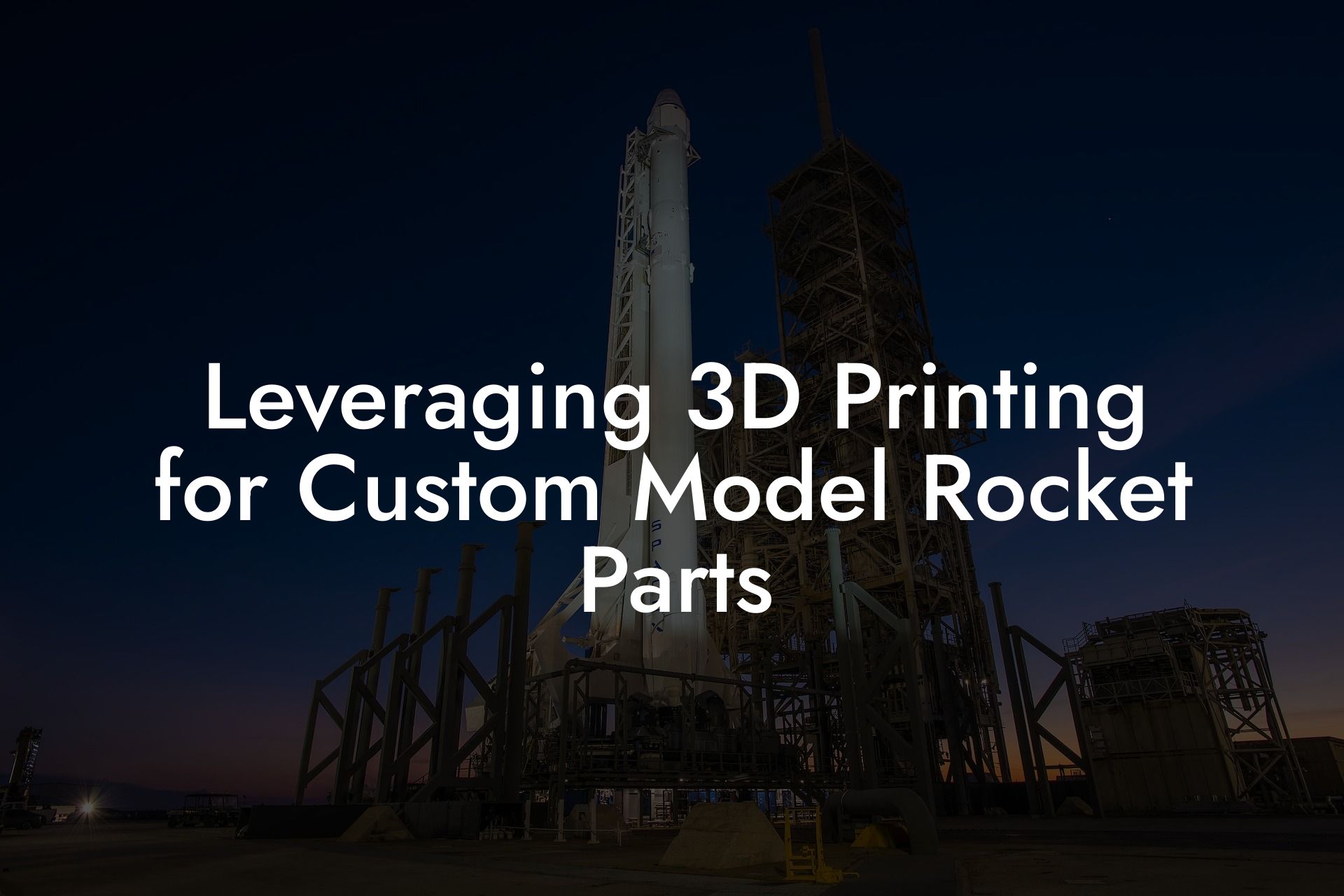3D printing is revolutionizing model rocketry by allowing enthusiasts to design and fabricate custom parts with incredible precision and speed. "Leveraging 3D Printing for Custom Model Rocket Parts" explores how this technology can transform your builds, from bespoke fins and nose cones to intricate engine mounts and modular components, empowering you to push the boundaries of design, performance, and personalization.
Quick Links to Useful Sections
- Introduction: The Digital Fabrication Revolution in Rocketry
- Benefits of 3D Printing in Model Rocketry
- Designing Custom Parts: Tips and Techniques
- 1. Start with Detailed CAD Modeling
- 2. Optimize for Weight and Strength
- 3. Consider Material Properties
- 4. Test and Iterate
- Applications of 3D Printing in Custom Rocket Parts
- Case Studies: Success Stories in 3D Printed Rocketry
- The Custom Fin Upgrade
- Precision Engine Mounts
- Modular Multi-Stage Connectors
- Model Rocket 3D Printing FAQs
- Your Next Launch: Unleash Your Creativity with 3D Printing and Soar to New Heights
Introduction: The Digital Fabrication Revolution in Rocketry
The advent of 3D printing has opened up a world of possibilities in model rocketry. No longer are you confined to pre-made parts or expensive machining processes; you can now design, iterate, and produce custom components right from your home workshop. This technology enables rapid prototyping, reduces material waste, and provides unparalleled design freedom. Whether you're a beginner looking to experiment or an advanced rocketeer aiming for record-breaking flights, 3D printing is your ticket to innovation.
Benefits of 3D Printing in Model Rocketry
3D printing offers a variety of advantages that make it a game changer in the rocketry community:
- Customization: Create parts tailored to your exact specifications, from aerodynamic nose cones to uniquely designed fins.
- Rapid Prototyping: Quickly produce prototypes and test designs without lengthy manufacturing processes.
- Cost Efficiency: Reduce costs by printing parts on demand, using minimal material waste and eliminating the need for expensive tooling.
- Complex Geometries: Produce intricate designs that would be impossible or cost-prohibitive with traditional manufacturing methods.
- Iterative Improvement: Easily modify and reprint parts based on flight test data and feedback for continuous performance enhancements.
Designing Custom Parts: Tips and Techniques
When leveraging 3D printing for model rocket parts, thoughtful design is crucial. Consider these tips to get the best results:
1. Start with Detailed CAD Modeling
Use CAD software such as Fusion 360, SolidWorks, or free alternatives like Tinkercad to design your parts with precision. Ensure you include detailed measurements and tolerances, as even slight deviations can affect aerodynamic performance.
Looking For The Best Model Rocket Kits? You'll Love These:
2. Optimize for Weight and Strength
Material selection and design optimization are key. Use lattice structures or infill patterns to reduce weight while maintaining structural integrity, especially for critical components like engine mounts and fin assemblies.
3. Consider Material Properties
Different 3D printing materials offer unique properties. PLA is easy to print and cost-effective, while ABS provides better durability and heat resistance. For high-performance parts, consider advanced materials like PETG or composite filaments infused with carbon fiber.
4. Test and Iterate
Print prototypes and perform ground tests to validate fit, strength, and aerodynamic properties. Use the feedback from these tests to refine your design and reprint improvements.
Applications of 3D Printing in Custom Rocket Parts
3D printing can be applied across a wide range of rocket components:
- Nose Cones: Design sleek, aerodynamic nose cones with complex internal geometries to optimize airflow.
- Fins: Create custom fin shapes that enhance stability and reduce drag, tailored to your rocket’s specific flight profile.
- Engine Mounts: Fabricate precise engine mounts that securely hold your engine in place and absorb launch vibrations.
- Interstage Connectors: Build modular connectors that enable multi-stage designs and easy assembly/disassembly.
- Payload Bays: Customize payload compartments to securely hold cameras, sensors, or other experimental equipment.
Case Studies: Success Stories in 3D Printed Rocketry
Real-world examples demonstrate the transformative impact of 3D printing in model rocketry:
The Custom Fin Upgrade
One enthusiast redesigned and printed a new set of fins using a lightweight lattice structure. After iterative testing and optimization, the custom fins reduced drag by 15% and significantly improved flight stability.
Precision Engine Mounts
Another rocketeer used 3D printing to create custom engine mounts with integrated vibration dampening. The enhanced design not only improved engine alignment but also extended the engine’s operational lifespan.
Modular Multi-Stage Connectors
A team of advanced rocketeers developed modular interstage connectors that allowed for quick swapping of stages, enabling rapid prototyping and testing of different multi-stage configurations.
These success stories highlight the potential of 3D printing to drive innovation and enhance performance in model rocketry.
Model Rocket 3D Printing FAQs
Here are some frequently asked questions to help you leverage 3D printing for custom rocket parts:
1. What are the benefits of using 3D printing in model rocketry?
3D printing allows for unparalleled customization, rapid prototyping, and cost-effective production of complex parts, enabling you to optimize design and performance.
2. Which 3D printing materials are best for rocket components?
PLA is great for beginners due to its ease of use, while ABS and PETG offer better durability and heat resistance. For high-performance parts, consider composite filaments like carbon fiber-infused materials.
3. How do I ensure that my 3D printed parts are strong enough for flight?
Optimize your designs with appropriate infill patterns and wall thicknesses, and use stress analysis tools within your CAD software to simulate loads and verify structural integrity.
4. Can I design parts that are both lightweight and strong?
Yes, by using lattice structures and careful material selection, you can design parts that achieve an excellent strength-to-weight ratio.
5. What software should I use for designing custom rocket parts?
Popular CAD tools include Fusion 360, SolidWorks, and Tinkercad. These programs offer robust design and simulation features to help you create precise models.
6. How do I test the aerodynamic performance of 3D printed parts?
Use CFD simulation tools to model airflow over your parts and perform ground tests to validate performance before full-scale launches.
7. Are there any cost-effective ways to start with 3D printing for rocketry?
Many affordable desktop 3D printers are available, and open-source software like Tinkercad and FreeCAD can help you get started without a significant upfront investment.
8. How do I integrate 3D printed parts with other components in my rocket?
Design standardized interfaces and connection points in your CAD models to ensure a snug fit with other rocket components, allowing for seamless integration.
9. Can I modify my designs based on flight test data?
Absolutely. One of the greatest advantages of 3D printing is the ability to quickly iterate on your designs based on feedback and performance data from test flights.
10. Where can I find inspiration and resources for 3D printing in rocketry?
Online rocketry forums, maker communities, and 3D printing websites offer tutorials, design files, and inspiration for innovative rocket part designs.
Your Next Launch: Unleash Your Creativity with 3D Printing and Soar to New Heights
Embrace the power of 3D printing to customize your rocket parts and push the limits of your design. With the ability to rapidly prototype and iterate on your ideas, you can create a model rocket that is truly one-of-a-kind. Equip yourself with the right digital tools, experiment boldly, and watch your custom creations take flight.
The future of rocketry is at your fingertips, start designing, printing, and launching your innovative creations today!
Looking For The Best Model Rocket Kits? You'll Love These:
Useful Interruption: Dive deeper into the world of Model Rockets with our most popular sections. If there is anything you think is missing or anything you would love for us to write about, just give us a shout.
- Getting Started & Basics With Model Rockets
- Model Rocket Design, Build & Customization
- Model Rocket Propulsion & Engine Technology
- Model Rocket Launch Techniques & Recovery
- Model Rocket Advanced Rocketry & Innovations
- Model Rocket DIY and Customization
- Model Rocket Equipment Reviews & Digital Tools
- Community, Competitions & Education
- Model Rocket Troubleshooting & FAQs
- Model Rocket Bonus/Seasonal & Niche Topics
A group of model rocket enthusiasts gathered at a field for their weekly launch event. Among them was Dave, a seasoned builder known for pushing the limits of hobby rocketry. This time, he had outdone himself.
“Ladies and gentlemen,” Dave announced, dramatically pulling a cloth off his latest creation, “I present to you: The Kraken!”
The crowd gasped. This wasn’t just a model rocket, it was a monster. The thing stood 8 feet tall, had six clustered engines, and was covered in enough duct tape to qualify as a classified aerospace project.
“Dave,” muttered Steve, the cautious safety officer, “Have you, uh… done the math on this?”
“Math?” Dave scoffed. “I built it in my garage at 3 a.m. with parts from eBay. This is an art piece, Steve.”
The countdown began.
5…
4…
3…
2…
1…
The engines ignited with a BOOM, and The Kraken shot up… kind of. It immediately did a violent barrel roll, narrowly missing the spectators before skyrocketing at an angle that could only be described as “legally questionable.”
The crowd collectively ducked as The Kraken flew straight over the adjacent cornfield, where Old Man Jenkins, the grumpiest farmer in town, was minding his business.
KABOOM!
The rocket disappeared behind the barn. A moment later, a flaming piece of Estes igniter wire landed at Steve’s feet. The silence was deafening.
And then, an unmistakable sound echoed across the field.
Jenkins’ shotgun being cocked.
“DAVE!!!” Steve shouted. “RUN.”
And that was the day Dave invented the first-ever biologically powered rocket booster: pure adrenaline.
To this day, nobody knows where The Kraken landed, but legend has it, it still haunts the skies, terrifying unsuspecting drones and low-flying birds.








